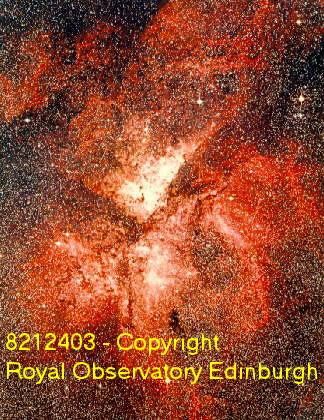

The Eta Carinae Nebulae is a collection of bright and dark nebulae, bright stars and star clusters in the Southern Milky Way not far from the Southern Cross. At a declination of -60 degrees it is too far south to be visible from Europe. When first recorded by astronomers in 1677 the star Eta Carinae, after which the nebula is named, was 4th magnitude in brightness but it was soon recognised to be variable and is now fainter than magnitude 6 (the limit for naked eye observation). However, in 1843, it flared (to magnitude -1) to become the brightest star in the sky after Sirius and then faded to about magnitude 8. Eta Carinae is at a distance of over 4000 light years which means that at its brightest its luminosity was about 1 million times that of the Sun and even now is about 1600 times that of the Sun.
The nebula is catalogued as NGC 3372, is also known as the "Keyhole Nebula" and is visible as a large diffuse patch of bright nebulosity against a background of star clouds and bright and faint nebulosity. The whole nebula is divided into sections by dark lanes consisting of gas and dust; these clouds are probably foreground dark clouds and not associated with the bright nebula. The "key-hole" itself is a dark island in the brightest part of the nebulosity just to the north of the centre of this picture; the star Eta Carinae is just to its east (left).
The bright nebulosity is ionised hydrogen gas which is excited by several very hot, young stars embedded in the nebula indicating that star formation is occurring in this region. Most of these stars are hidden by the nebulosity in this picture but would be seen easily with a small telescope. The open star cluster in the northwest corner (top right) is NGC 3293; this is surrounded by some blue "reflection nebulosity". The nebulosity just to the southwest of this cluster is NGC 3324 and is illuminated by a very hot O-star in the centre.
North is up and East to the left. The area shown covers an area of sky about 3.5 degrees x 2.5 degrees (about the area covered by 35 full moons).
(This photograph was made from three black and white photographic plates, exposed through blue, green and red coloured filters, taken with the UK Schmidt Telescope in Australia. The colour picture is produced by sequentially printing the original photographs through the appropriate colour filter onto colour material. Colour film, as used for conventional photography, does not register the true colour in objects such as this nebula. The three-colour process as used here allows the beautiful colours of the nebulosity and the surrounding stars to be revealed.)